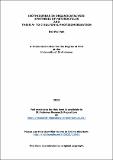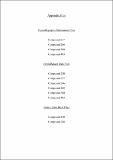Files in this item
Isothioureas in organocatalysis : synthesis of heterocycles and their N- to C-sulfonyl photoisomerisation
Item metadata
| dc.contributor.advisor | Smith, Andrew David | |
| dc.contributor.author | Yeh, Pei-Pei | |
| dc.coverage.spatial | 265 p. | en_US |
| dc.date.accessioned | 2017-10-31T14:06:09Z | |
| dc.date.available | 2017-10-31T14:06:09Z | |
| dc.date.issued | 2015-07 | |
| dc.identifier.uri | https://hdl.handle.net/10023/11961 | |
| dc.description.abstract | Chapter 1 describes an introduction to the area of organocatalysis and delineates previous work within the Smith group on the use of isothioureas in asymmetric catalysis. Chapter 2 showcases a one-pot isothiourea-catalysed Michael addition-lactamisation using cheap and readily available starting materials (carboxylic acids) and easily prepared α,β-unsaturated ketimines via an ammonium enolate intermediate to give dihydropyridinones with high diastereo- and enantioselectivity (typically >90:10 dr, up to 99% ee). The resultant dihydropyridinones can be successfully derivatised into multiple products without erosion of stereointegrity. In chapter 3 the same concept has also been applied to the synthesis of planar molecules by using (phenylthio)acetic acid as a suiTable ammonium enolate precursor. Generation of an ammonium enolate using an achiral isothiourea (DHPB) and reaction with α,β-unsaturated trifluoromethyl ketones allows an isothiourea-mediated Michael addition / lactonisation / thiophenol elimination cascade reaction for the formation of 4,6-disubstituted and 3,4,6-trisubstituted 2-pyrones in good to excellent yields (61-99%). Notably this method allows low catalyst loadings of 1% to be used. The methodology has successfully been applied to the synthesis of a COX-2 inhibitor and a wide range of derivatisations has been performed, giving valuable aromatic and heteroaromatic products containing the trifluoromethyl motif. In chapter 4 a novel N- to C-sulfonyl migration of dihydropyridinones via photoisomerisation is investigated. The scope and limitations of this process is investigated and the process is shown to proceed without compromising the diastereo- or enantiomeric purity of the starting material, giving 5-sulfonyl products in good to excellent yields (67-95%). Mechanistic crossover has indicated that this migration includes an intermolecular step, while EPR studies provided evidence of its radical nature. | en_US |
| dc.language.iso | en | en_US |
| dc.publisher | University of St Andrews | |
| dc.subject.lcc | QD400.Y4 | |
| dc.subject.lcsh | Catalysis | en |
| dc.subject.lcsh | Heterocyclic chemistry | en |
| dc.subject.lcsh | Photoisomerization | en |
| dc.title | Isothioureas in organocatalysis : synthesis of heterocycles and their N- to C-sulfonyl photoisomerisation | en_US |
| dc.type | Thesis | en_US |
| dc.type.qualificationlevel | Doctoral | en_US |
| dc.type.qualificationname | PhD Doctor of Philosophy | en_US |
| dc.publisher.institution | The University of St Andrews | en_US |
This item appears in the following Collection(s)
Items in the St Andrews Research Repository are protected by copyright, with all rights reserved, unless otherwise indicated.


